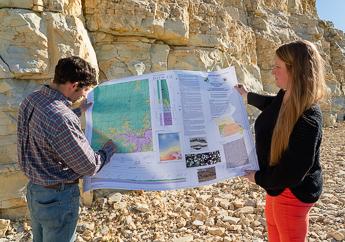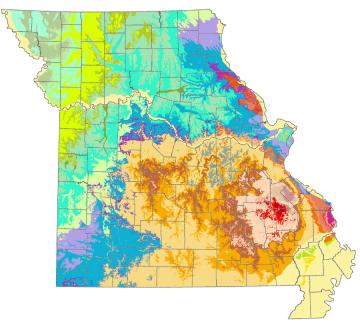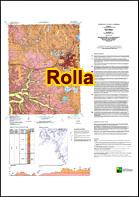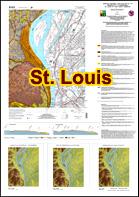
Learn about geologic maps today and especially on Geologic Map Day, which will be held Oct. 13, 2023 (during Earth Science Week). Geologic Map Day is a special event designed to promote awareness of the study, uses, importance of geologic mapping for education, science, business, and a variety of public policy concerns. Geologic maps are important for education, science, business, and a variety of other public policy concerns. Geologic Map Day will focus the attention of students, teachers, and the general public on the study, uses, and significance of these tools, by engaging audiences through educational activities, print materials, online resources, and public outreach opportunities.

Geologic maps, produced by the department’s Missouri Geological Survey, depict rock type, distribution, properties and its relative age. They provide information about the Earth’s structure and provide a baseline for data related to energy resources, mineral resources, natural hazards, water resources, soil conservation and climate science. Virtually all mineral, energy, water, industrial construction, public works and urban development projects can benefit from a geologic map.
Visit our Ed Clark Museum of Missouri Geology on Geologic Map Day to learn more about geologic maps. Open weekdays from 8 a.m. to 4:30 p.m., we are located at 111 Fairgrounds Road, Rolla. Admission to the museum is free of charge.
Bedrock geologic maps provide information about the existing layering of bedrock and faulting, folding or deformation. They include information about the distribution of rock such as limestone, sandstone, coal and granite. Surficial material maps describe deposits that occur above bedrock. This includes soil, but also details up to several hundred feet of deeper unconsolidated material.
- Geologic Map Index ArcGIS Web Application - Locate geologic maps produced by the department.
- Geologic Maps - Learn about the variety of maps produced by the department.
- Follow the Water – Understanding Springs in the Missouri Ozarks – Interactive Story Map.
These maps and others can be purchased by visiting us at 111 Fairgrounds Road in Rolla, or by calling us. Low resolution images of many may be viewed by visiting the Geologic Map Index.
What is a geologic map?
Like all maps, a geologic map shows where things are. But while other maps highlight where you can find things like streets and streams, a geologic map shows the distribution, nature, and age relationships of rocks, faults, strata, and other geologic features.
How do you read a geologic map?
Each geologic map has a map key, which is a table explaining the meanings of all colors and symbols used to represent geologic features in the map. For example, geologic units usually are listed in order from the youngest (most recently formed) rock types to the oldest (formed earliest in time). The key often will give the name of the each unit, as well as the age and a brief description of that unit’s rocks.
In addition to units, the key usually explains the map’s use of lines and symbols. Lines might show where two units meet and perhaps bend, fold, and warp up against one another. Symbols might indicate where you can find things like fossils, precious metals, or active faults.
A strike and dip symbol, for instance, is a T-shaped symbol that shows where layers of rock stack up in tilted beds. The number accompanying a strike and dip symbol indicates the angle, or tilt, of the rock bed.
How do you use a geologic map?
Like people all over the world, your life is shaped by the geology of your area. Is the ground good for building or farming? Are you likely to find available groundwater? What natural resources are there underground? What is the likelihood of a natural disaster such as an active volcano or earthquake?
Geologic maps are used to identify many features and phenomena, from coal resources and potential landslides to vital ecosystems and animal habitats. Geologic maps are necessary to help us navigate among the many challenges and opportunities offered by the dynamic Earth systems that surround us.
(Adapted from Geologic Maps, USGS, and Meeting Challenges With Geologic Maps, AGI.)








